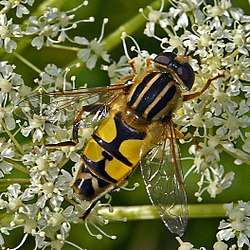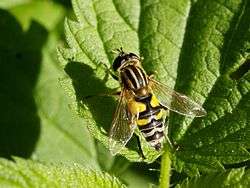Helophilus trivittatus
Helophilus trivittatus is a species of Palearctic hoverfly.[1]
| Helophilus trivittatus | |
|---|---|
 | |
| Helophilus trivittatus. Male | |
| Scientific classification | |
| Kingdom: | |
| Phylum: | |
| Class: | |
| Order: | |
| Family: | |
| Subfamily: | |
| Tribe: | |
| Genus: | |
| Species: | H. trivittatus |
| Binomial name | |
| Helophilus trivittatus (Fabricius, 1805) | |
| Synonyms | |
Etymology
The scientific genus name is composed of the parts helos (ἕλος, gr.), meaning "marsh" and philos (φίλος, gr.) meaning "friend". The species name is composed by "tri" (lat.), meaning "three" and "vitta" (lat.) meaning "band". This name refer to the preference of these insects for moist areas and to the fact that they carry three stripes on the breast shield.
Description
For terms see Morphology of Diptera

Helophilus trivittatus has a wing length of 10.25–12.25 millimetres (0.404–0.482 in). The eyes are separated in both sexes, in the male a little less than in the female. The antennae are black, Face shows a wide yellow longitudinal stripe, with at most a central reddish-brown stripe.[2] On the thorax four narrow pale yellow stripes alternate with three larger dark brown stripes. The drawing of the flattened abdomen is reminiscent of a wasp.
The drawing of the third and fourth segments of the abdomen is different in the two sexes. In the male, only the third segment carries a pale yellow to gray arc line. In the female, such a curve is found on the fourth and the fifth tergite.[3] Tergites 2 and 3 have pale lemon yellow spots, while tergite 4 has white to grey spots. In the females tergite 3 yellow spots touch the front margin. The larva is illustrated by Hartley (1961) [4]
Distribution
This species is present in most of Europe and in the East Palearctic ecozone.[9] It is widespread from Palearctic Fennoscandia South to the Mediterranean basin and from Ireland East through Europe, Russian Far East and Siberia to the Pacific. Iran and Afghanistan.[10] It has been observed migrating in Sweden.[11]
Habitat
These hoverflies inhabit wetland, river margins, seasonally flooded grassland and salt-marsh. They are anthropophilic in southern Europe, where it frequents irrigation ditches in farmland.[12]
Biology
The flight period of this species is from May to October. Adults feed on various flowers, including umbellifers, yellow composites, Armeria, Aster, Cakile, Centaurea, Chrysanthemum, Cirsium, Crataegus, Epilobium angustifolium, Eryngium, Eupatorium, Euphorbia, Ligustrum, Lychnis, Lythrum, Mentha, Menyanthes, Origanum, Plumbago, Polygonum persicaria, Potentilla, Ranunculus, Rubus fruticosus, Salix and Sorbus.[13] The larva is a detritivore associated with decaying rhizomes of Typha latifolia and with beds of Glyceria maxima.
References
- Stubbs, Alan E.; Falk, Steven J. (1983). British Hoverflies: An Illustrated Identification Guide. British Entomological & Natural History Society. pp. 253, xvpp.
- Stuart Ball, Roger Morris Britain's Hoverflies: A Field Guide, Revised and Updated Second Edition
- Nature Spot
- Hartley, J.C. (1961) A taxonomic account of the larvae of some British Syrphidae. Proc.zool.Soc.Lond.,136: 505-573.
- Van Veen, M. (2004) Hoverflies of Northwest Europe: identification keys to the Syrphidae. 256pp. KNNV Publishing, Utrecht.addendum
- Van der Goot,V.S. (1981) De zweefvliegen van Noordwest - Europa en Europees Rusland, in het bijzonder van de Benelux. KNNV, Uitgave no.32: 275pp. Amsterdam.
- Bei-Bienko, G.Y. & Steyskal, G.C. (1988) Keys to the Insects of the European Part of the USSR, Volume V: Diptera and Siphonaptera, Part I. Amerind Publishing Co., New Delhi. ISBN 81-205-0080-6.
- Coe, R.L. (1953) Diptera: Syrphidae. Handbks.ident.Br.insects, 10(1): 1-98. R.ent.Soc.London. pdf
- Fauna Europaea
- Peck, L.V. (1988) Syrphidae. In: Soos, A. & Papp, L. (eds.) Catalogue of Palaearctic Diptera, 8: 11-230. Akad.Kiado, Budapest.
- Speight, M.C.D. (2011). "Species accounts of European Syrphidae (Diptera)" (PDF). Syrph the Net, the database of European Syrphidae. 65: 285pp.
- de Buck, N. (1990) Bloembezoek en bestuivingsecologie van Zweefvliegen (Diptera, Syrphidae) in het bijzonder voor België. Doc.Trav. IRSNB, no.60, 1-167.